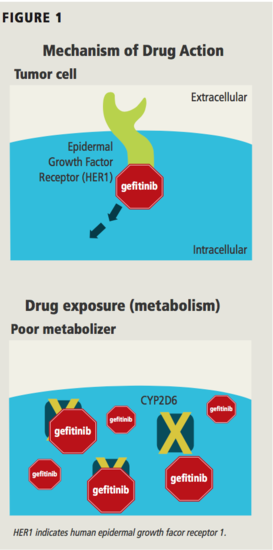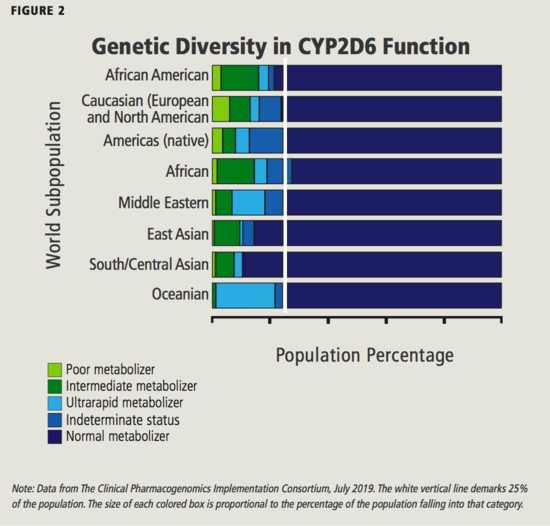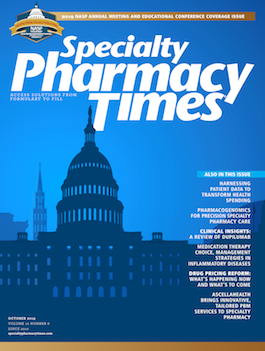Pharmacogenomics for Precision Specialty Pharmacy Care
Personalized precision medical care addresses as many unique characteristics of the patient as possible.
Treatment response variability is a significant complicating factor in medical care. Personalized precision medical care addresses as many unique characteristics of the patient as possible. These include genetic, medical, and environmental factors. Pharmacogenomics studies the effects of acquired and inherited genetic variations on drug response by correlating genetics with pharmacokinetics and pharmacodynamics. This area was the focus of a key session during the 2019 National Association of Specialty Pharmacy Annual Meeting and Expo.
Genetic biomarkers have relevance in drug efficacy when the mechanism of drug action depends on an appropriate biomarker profile. Further, pharmacogenomic biomarkers can guide patient-specific drug dosing, predict the patient’s drug exposure at a fixed dose, and alert clinicians to increased risk for adverse drug events.
The oncology drug gefitinib is a real-world example demonstrating multiple pharmacogenomic principles. Gefitinib is a National Comprehensive Cancer Network—recommended first-line option for metastatic non–small cell lung cancer, if the tumor has the appropriate pharmacogenomic biomarker.1 In a healthy human cell, one of the signaling receptors on the cell surface is the epidermal growth factor receptor (EGFR). The gene for this receptor is called human epidermal growth factor receptor 1 (HER1). When the signaling ligand binds the EGFR, the receptor becomes active and is capable of initiating a cascade of events inside the cell leading to growth and proliferation. In a tumor with the appropriate genetic biomarker profile for gefitinib, HER1 has acquired mutations such that EGFR is constantly active, causing unregulated cell growth and proliferation.
Gefitinib is a small molecule EGFR inhibitor that stops these overactive receptors, thereby halting the unregulated signals for cell growth and proliferation (FIGURE 1). Its efficacy to halt tumor growth is determined by the genetic profile of the tumor; this is indicated in the FDA drug label information.2
Gefitinib has a second pharmacogenomic interaction related to drug metabolism. It is metabolized within the liver by the enzyme CYP2D6, whose function varies widely between people; because this is an inherited trait. Patients with genetic profiles associated with fully functional CYP2D6 enzymatic activity are called normal metabolizers; for them gefitinib is predictably cleared from the body. In patients who inherited severely reduced CYP2D6 enzyme activity, getifinib is not efficiently metabolized.
At therapeutic doses, the drug accumulates, causing a papulopustular rash of grade 2 or higher on the face and torso, increasing the potential of nonadherence.3 This adverse drug effect is serious enough to require treatment in 10% to 15% of patients.4,5 The biomarker profile, a genetic test of the CYP2D6 gene, for this pharmacogenomic relationship requires a nontumor DNA sample and is not indicated in the FDA drug label information. A comprehensive specialty pharmacy pharmacogenomic program would take into account both the tumor and patient genetic profiles to best treat the disease and the patient.
The 2 pharmacogenomic interactions of gefitinib have many differences (FIGURE 1).

One interaction is specific to the tumor, determining if the drug will be effective, and the other is specific to the patient, determining the potential for an adverse drug effect. A clinically relevant factor to consider when prioritizing testing for inherited genetic variability, such as with drug-metabolizing enzymes, is how common is variability across the relevant genes within your specific patient population. There is broad genetic diversity in CYP2D6 function across the population, but the probability a patient has reduced CYP2D6 enzyme function depends on the ethnic background of the patient (FIGURE 2).

African Americans and Africans are the largest populations of reduced CYP2D6 metabolizers, which includes poor and intermediate metabolizers, while Caucasians account for the largest population of poor metabolizers but significantly fewer intermediate metabolizers. The most appropriate and accurate genetic test for a patient population considers many characteristics of the patient population.
There are many considerations when comparing and selecting pharmacogenomic testing providers. Foremost, a specialty pharmacy must be aware that there is no standardization between testing providers. Each tests for a unique panel of genes, potentially uses different names for the same gene, and tests for different mutations within those genes. Secondly, there are many types of laboratory testing methodologies, each with differing abilities to detect variation in DNA sequences and intrinsic false-positive and false-negative rates associated with those methods.
Also, the sample collection method affects the quality and quantity of DNA available for testing. An at-home oral swab is the least invasive and most convenient method, but it has the highest variability in DNA quality and quantity. A whole blood clinical sample is more invasive but provides reliably high-quality DNA. Lastly, genetic testing of patients who’ve undergone a stem cell or liver transplant is less informative because they now carry 2 genomes in tissues relevant to the absorption, distribution, metabolism, and excretion of pharmaceuticals.
Creating a comprehensive pharmacogenomic precision care program begins with envisioning the ultimate end point product and structuring a system that meets the unique goals and needs of your organization. A few areas to consider include knowing the patients you want to target for enrollment; identifying appropriate testing partners; having ready a model of preemptive or responsive genetic testing, such as for when a drug fails to produce a result; and providing decision support tools, taking into account the target audience for these tools.
Looking to the future, what trends are on the horizon for pharmacogenomics in specialty pharmacy? I predict we will begin to see more data on drug effects in rare and orphan diseases. In addition, research from academia and industry will help us better understand and clinically address combinatorial pharmacogenomic effects involving multiple genes. Lastly, widespread adoption of pharmacogenomics will require intelligently designed automated decision support to facilitate timely patient evaluation so clinicians can focus on the patient, not the data.
The value of a specialty pharmacy pharmacogenomic program lies in its ability to improve health outcomes while reducing the total cost of care through genetics-based selection of an optimal treatment course. The appropriate and accurate application of patient genetic data can avoid a costly trial-and-error treatment course and reduce adverse drug events that frequently lead to additional pharmaceutical or medical interventions and nonadherence.

